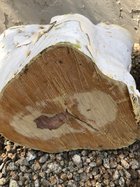-
It's time to cast your vote in the December 2025 Turning Challenge. (click here for details) -
Congratulations to Pat White for "Sicilian Mosaic" being selected as Turning of the Week for December 29, 2025 (click here for details) -
Welcome new registering member. Your username must be your real First and Last name (for example: John Doe). "Screen names" and "handles" are not allowed and your registration will be deleted if you don't use your real name. Also, do not use all caps nor all lower case.
You are using an out of date browser. It may not display this or other websites correctly.
You should upgrade or use an alternative browser.
You should upgrade or use an alternative browser.
Wood ID help
- Thread starter Michael Luksich
- Start date
- Joined
- Apr 27, 2004
- Messages
- 9,308
- Likes
- 6,080
- Location
- Lakeland, Florida
- Website
- www.hockenberywoodturning.com
The shedding bark and the trunk contour is like crepe myrtle.
Just throwing it out as a possibility. Do they grow in Arizona?
It is usually an ornamental shrub tree. It can get over 2 feet in diameter
Just throwing it out as a possibility. Do they grow in Arizona?
It is usually an ornamental shrub tree. It can get over 2 feet in diameter
Yes, they do grow in AZ. Very heavy.....definitely wet wood!!
Possible Western Sycamore?
Picture of the leaves? Or bark
Looks like Birch to me, it does grow often in clumps of a few stems, as it looks like that in the picture with also bark inclusion between a couple of stems,
and yes the bark is peeling from White and Paper Birch
and yes the bark is peeling from White and Paper Birch
Last edited:
I have found a couple of descriptions and photos that would make me lean to Arizona Sycamore....thanks!!! I will follow up when I turn it. Cheers.
You could be richt Michael, the picture is not showing a lot of the top and side, so I was going by what I can see in the picture, where you can see it al much better.
Anyway I have Birch growing here and I have seen and worked with Sycamore, though the Arizona Sycamore is just a little different, like the leafs are not like a Maple leaf kind of, anyway, I did get a picture on line of the Sycamore and I have pictures of Birch, so Ill add these here.
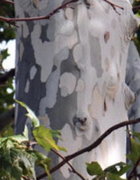
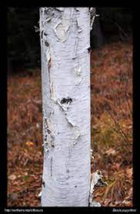
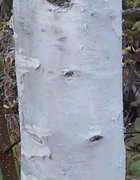
Anyway I have Birch growing here and I have seen and worked with Sycamore, though the Arizona Sycamore is just a little different, like the leafs are not like a Maple leaf kind of, anyway, I did get a picture on line of the Sycamore and I have pictures of Birch, so Ill add these here.



Wow.....thanks for the info. Nature is both amazing and overwhelming. I will try and check with the person who cut it down about more info on the leaf. With appreciation!!!!
Leo,
My first thought was paper birch, as well, but I decided the peeling bark didn't look quite right. On birch, it's generally very thin and on the OP's picture, it's fairly thick. With birch, if you get a thicker bark peeling, the underside is creamy or tan, and while this stuff has some buff coloring on the peeling bark, it doesn't quite have the right look. And most importantly, on birch there are many, many short horizontal marks on the bark, and the OP's picture shows nearly none.
My first thought was paper birch, as well, but I decided the peeling bark didn't look quite right. On birch, it's generally very thin and on the OP's picture, it's fairly thick. With birch, if you get a thicker bark peeling, the underside is creamy or tan, and while this stuff has some buff coloring on the peeling bark, it doesn't quite have the right look. And most importantly, on birch there are many, many short horizontal marks on the bark, and the OP's picture shows nearly none.
Dean I see the hin bark in the OP's picture, and yes Birch has the thin (Paper like) peeling bark, as for the lines on the bark, they are not always there, it is very variable from tree to tree.Leo,
My first thought was paper birch, as well, but I decided the peeling bark didn't look quite right. On birch, it's generally very thin and on the OP's picture, it's fairly thick. With birch, if you get a thicker bark peeling, the underside is creamy or tan, and while this stuff has some buff coloring on the peeling bark, it doesn't quite have the right look. And most importantly, on birch there are many, many short horizontal marks on the bark, and the OP's picture shows nearly none.
Here is a Birch log with smooth bark and hardly any lines on it.
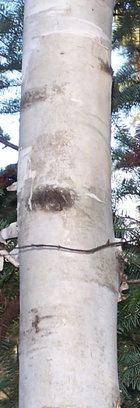
And here are two Birch trees, a thin one and thicker one that have a rough bark and the lines on it.
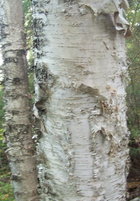
And here is a larger Sycamore I turned, it's bark is much rougher and darker than some smaller Sycamores, things are often very variable in nature, depending the condition these trees are growing in.
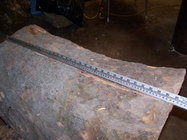
Here is the OP's picture with the thin peeling bark, but what throws me off right now (looking at the picture again is the green color under the outer bark, so yes this could very well be a Sycamore, I'm always interested in these things and still learning at almost 80 years old ;-))
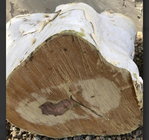
Last edited:
If it is sycamore, stay away from the pith. I've had several rings close to the pith suddenly turn loose, even 1" to 1 1/2" away.
I have never seen that Marvin, mind you a tree that has been in a bad storm could get wind-shake, and I don't believe that it grows back together.If it is sycamore, stay away from the pith. I've had several rings close to the pith suddenly turn loose, even 1" to 1 1/2" away.
I do have some Sycamore logs sitting here (some sit here already for 10 years plus) and as it happens I have a 19" bowl that I just finished this past week, a couple pictures here that will show no loose rings, of course I have not seen all Sycamore logs, but seen a few, plus I also don't recall other turners mentioning this, still it is always good to have a good close look at the wood before starting to cut it up or turning it
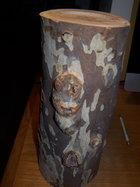
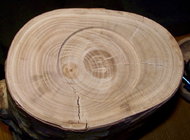
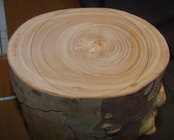
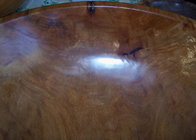
They cleared the side of the road to double the highway years ago and I got several 24 to 30" logs actually still have about 4 pieces I have kept out of the weather. Some turned loose first turning them and some came loose on the return...now I cut at least 4" out with the pith. Several trees there and they all acted the same. The problem that I had, there was no visible sign they were coming out but when hollowing out the inside of the bowl if I was too close to the pith the whole ring would release...I turned several beautiful bowls out of that wood, one of my daughters has one of the biggest bowls I've made, back when I thought everyone would want a huge bowl. I have not harvested any more sycamore, mainly for that reason. Now I'm curious if there was an issue with just those trees? Anyone else turned sycamore with wood close to the pithe turning loose? These trees were freshly cut, only on the ground a day or two when I got them.
- Joined
- Feb 28, 2021
- Messages
- 1,778
- Likes
- 1,592
- Location
- Roulette, PA
- Website
- www.reallyruralwoodworks.com
I doubt it is just Sycamore. I have seen this happen on Apple and Cherry as well, both later identified as ring shake - Ring shake is not always visible and sometimes it doesn't manifest until you get close to finish, Other times it manifests while the wood is drying - It is still ring shake any way you slice it, and I doubt it happens just to any one species.. Your wood being roadside, makes me wonder if that ring shake might not have happened while the tree was still young (since it is closer to pith) and could be caused by blast of wind as a tractor trailer goes speeding by, as easily as not, especially if it is while the young tree is more "bendable" (Just my thought on it, knowing how ring shake happens in the first place, but not knowing if it could be caused by wind blast from big trucks passing or what..) - Edit to add - And by the way much timber in our area was suddenly worthless after a tornado came through the region - even if tornado (or really high winds) doesn't take the tree down, Ring shake can still manifest, and as I understand it, timber buyers are gun-shy about buying standing timber that had been through an event such as that.. So, lot of trees in the area ended up being cut down for firewood.. even if they otherwise looked perfectly fine.Now I'm curious if there was an issue with just those trees? Anyone else turned sycamore with wood close to the pithe turning loose? These trees were freshly cut, only on the ground a day or two when I got them.
I went over to the old house and picked up a piece of that sycamore that one edge had fallen off the support and was touching the ground. I'm guessing 2010 or 2011 I chainsawed these into blocks and coated them with anchorseal. I sawed off the rotten corner then rounded it on the bandsaw. Last picture I just removed the last of the bark with the gouge, ready to give it it's final shape. It is presently 16" across. May leave it thick and set it on the shelf to see if it moves, seems really dry. Not a crack, or check or any issue. Only issue with this wood was right at the pith...
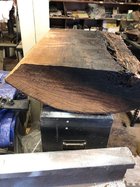
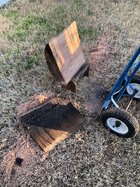
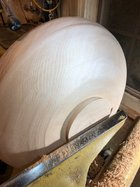



- Joined
- Feb 6, 2010
- Messages
- 3,466
- Likes
- 2,536
- Location
- Brandon, MS
- Website
- threeringswoodshop.square.site
If they pushed these trees down with a bulldozer that can also cause the ring shake much like a storm.They cleared the side of the road to double the highway years ago and I got several 24 to 30" logs actually still have about 4 pieces I have kept out of the weather. Some turned loose first turning them and some came loose on the return...now I cut at least 4" out with the pith. Several trees there and they all acted the same. The problem that I had, there was no visible sign they were coming out but when hollowing out the inside of the bowl if I was too close to the pith the whole ring would release...I turned several beautiful bowls out of that wood, one of my daughters has one of the biggest bowls I've made, back when I thought everyone would want a huge bowl. I have not harvested any more sycamore, mainly for that reason. Now I'm curious if there was an issue with just those trees? Anyone else turned sycamore with wood close to the pithe turning loose? These trees were freshly cut, only on the ground a day or two when I got them.
Gerald, I don't know or don't remember how those were dropped, I think I borrowed a triple axle trailer from work and they loaded the logs for me. They were cut and I don't remember seeing any damage to the trunks that a bulldozer would have made, I would have thought that kind of damage would be all through the trunk like the walnut I had did. I have looked at a bunch of threads in the forum some dating back to 2005 and no one talks about heartwood rings coming out. Probably the first three rings around the pith would peel out like potato chips one ring at a time, they were just cut down, slinging water everywhere so it was not a drying shrinking thing, just strange to me that only the very center rings would come out, kind of hard to envision damage that would cause that in a 30" trunk. Something caused it though...no one else has experienced it so it must have been unique to those trees.
- Joined
- Feb 28, 2021
- Messages
- 1,778
- Likes
- 1,592
- Location
- Roulette, PA
- Website
- www.reallyruralwoodworks.com
Oh yeah that seems classic ring shake, in my experience, ring shake has mostly all been in the heartwood (I have had, oh, a good dozen or so bowls I had to cut down or throw away when the heartwood rings surrounding the pith, up to 4 inches away, came loose, sometimes while wet turning, sometimes while second turning, and sometimes just from drying) Apple, and Cherry for the most part, and I had a couple air dried maple (and cherry) flat boards come apart while cutting them down - the end checking was invisible until I was done with the milling (jointing and planeing to thickness and width) and started cutting them to final lengths, which is when the boards "fell apart" (resulting in a lot of unprintable words!) and I had to go and mill another new board down to get the boards needed for the project. I've since learned (the hard way, obviously) to inspect my lumber much more closely and how to spot ring shake defects in those boards. It can be difficult to spot in green logs though, it isn't always readily obvious, but again in my experience, it seems most common in heartwood rings (closer to the center of the tree) probably because that part of the tree is not carrying any sap or nutrients, it doesn't grow any longer, its denser and less giving, can't heal itself as readily as sapwood would.Gerald, I don't know or don't remember how those were dropped, I think I borrowed a triple axle trailer from work and they loaded the logs for me. They were cut and I don't remember seeing any damage to the trunks that a bulldozer would have made, I would have thought that kind of damage would be all through the trunk like the walnut I had did. I have looked at a bunch of threads in the forum some dating back to 2005 and no one talks about heartwood rings coming out. Probably the first three rings around the pith would peel out like potato chips one ring at a time, they were just cut down, slinging water everywhere so it was not a drying shrinking thing, just strange to me that only the very center rings would come out, kind of hard to envision damage that would cause that in a 30" trunk. Something caused it though...no one else has experienced it so it must have been unique to those trees.
Woodweb has a forum where some of the sawmill guys talk about ring shake. Mostly it is a bacterial problem although tornadoes and other big windstorms can also contribute to shake in infested trees.
Cutting "shake" out of logs
What is shake, why does it occur, and how can it be removed? April 29, 2003
www.woodweb.com
Hmm, most of the sycamore we have out on the west coast is probably London Plane. Considerably different looking than the white ghost trunks I see back in Missouri when I visit. Got a dump truck load in my drive years ago. No ring shake in it at all. A 30 year old tree here can be 30 inches in diameter on the stump. I did get one once that was fire engine red on the inside, but 90% of the color was gone in a few hours after cutting. Never saw that before or since. There is one in a store parking lot where the bottom is all burl, kind of a cone that tapers up to the tree trunk. It has leaves like a sweet gum tree. Really messed with my tree identification, but 2 arborist friends confirmed Plane tree. If you do get one, quarter saw it. Rays are astounding. On hollow forms, you get at least one side that is spectacular.
robo hippy
robo hippy
As usual, great information guys! Dang Reed, the color disappearing would be a disappointment for sure.
John, I'll have to check that out, thanks. I've included a picture of a piece of oak that had an unusual pattern created by some type of bacterial issue. Tree was uprooted by a straight line wind that took out hundreds of trees here and in Memphis.
Brian, that must be what that is or was. If you noticed the way I cut the blank in the picture above, I stayed close to 6" away from the pith. I thought I had three or four of those pieces but when I checked yesterday, looks like there are closer to 10. I picked up the only one that had slipped off of the supports and was touching the ground and was amazed to find I could still get a 16" bowl out of it. Kind of plane without detail but pretty clear wood without issues.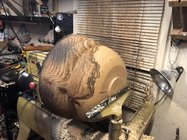
John, I'll have to check that out, thanks. I've included a picture of a piece of oak that had an unusual pattern created by some type of bacterial issue. Tree was uprooted by a straight line wind that took out hundreds of trees here and in Memphis.
Brian, that must be what that is or was. If you noticed the way I cut the blank in the picture above, I stayed close to 6" away from the pith. I thought I had three or four of those pieces but when I checked yesterday, looks like there are closer to 10. I picked up the only one that had slipped off of the supports and was touching the ground and was amazed to find I could still get a 16" bowl out of it. Kind of plane without detail but pretty clear wood without issues.

@Marvin Jones what are you making in that photo?
I used the straight McNaugton blade and cut two bowls out. That was a piece of green oak..

